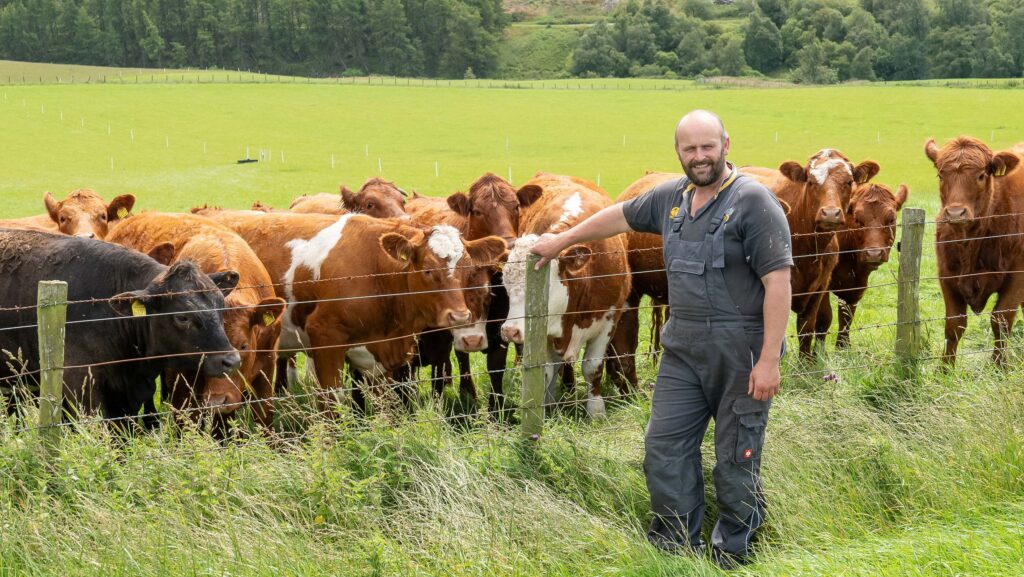How a dry autumn is benefitting grass utilisation
 John Ritchie © Angus Findlay
John Ritchie © Angus Findlay Beef and sheep farmer John Ritchie, winner of Farmers Weekly’s Grassland Manager of the Year 2023, replaced set stocking with rotational grazing on his Perthshire hill farm. He is sharing updates about his 2024 grazing season.
In the fourth and final of the series, John is reaping the benefit of a drier autumn with cattle still out grazing and good ground conditions pushing utilisation up.
See also: Grazing 2024 – a cool, damp summer favours swedes and clover
Sum up your grass-growing year in 2024
Good. We had quite a wet spring, which was difficult to manage. Summer has been fine, though we lacked sunshine till August, but then grass didn’t get away from us.
How much grass have you grown this year?
We have grown 8.3t of dry matter (DM) a hectare. This is down by about 0.3t DM on average, but it’s not a disaster. Grass growing caught up in late season and average farm cover is good now – we have about 2,600kg DM/ha.
What are conditions like for grazing?
We’re very lucky as it’s quite dry at the moment and cattle are still out. The forecast for the next 10 days is for dry weather, which means we can better utilise grass. With temperatures about 9-10C, we are due colder mornings with some sunshine. Much better than this time last year.
Are there signs of climate change on your farm?
Yes. It is helping us as we are growing more grass in winter and carrying it over. We are not getting the heavy snow and frosts, so we need to use this as an opportunity.
We wouldn’t take grass as silage after July (when we normally do our second cut) unless it was an exceptionally dry year – but we can always graze it.
Have you started feeding the swedes yet?
We will start grazing them in December with cows. We have saved more grass on the hill and can extend our cattle grazing for longer.
If it turns wet, we will put them on the swedes to avoid poaching.
Tell us how calf weaning went
All cattle are weaned now. We do it in three batches; the first is always the heaviest one and the third is the lightest. This year, they averaged 285kg at 180 days.
Weaning weights are good. Our best weights were 302kg and 315kg – that was with creep feeding, which costs money and time. I’m on my own and my time is valuable.
Calves have been weaned into a shed on silage (11.5MJ/kg DM of metabolisable energy) plus 1.5-2kg of concentrates till March.
Bullocks will then be sold and heifers kept on silage until turnout in mid-April. We will bull some and sell others for breeding.
What about this year’s lamb performance?
Lambs are slightly behind, though on course: all bar 3-4% will be gone by the end of November.
Lamb weights have been averaging 19.6kg deadweight, which is good, and up by 0.3kg.
We had a big block of red clover to graze, which definitely helped.
But our growing cattle weights were back by about 20kg at the start of September because we put them on a leader-follower behind the lambs as the red clover was getting ahead of them.
When do tups go in?
Sheep are grazing on rotation and tups will go in on 16 November. Ewes are in good condition. We have plenty of feed in front of them till new year.
Then they will move onto a hard standing where we feed silage till scanning.
After that, our best silage will be for twins and triplets till March.
Each standing has 2-2.5ha (5-6 acres) of very shallow soil over rock grazing, so they can’t make a mess and the rest of the farm gets 120 days of rest. It’s our “outdoor shed”.
What have you learned about grassland management this year?
How enjoyable it is when you have really started to build confidence in the system you have. Grassland management is cool.
Any changes planned for 2025?
This year, we had fewer sheep and more cattle. Next year, we will have fewer growing cattle at grass, but more cows and calves.
We usually buy in 20 stores from a neighbour. Instead, we’ll keep about 10% more of our own cows and calves as it’s more profitable.
I’m also planning plenty of farm visits this winter to see other systems and learn from them!
